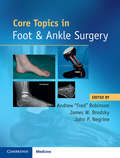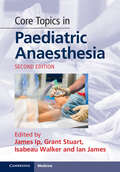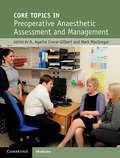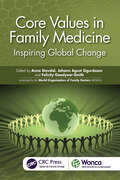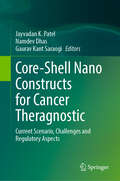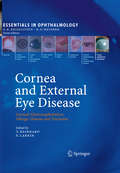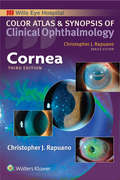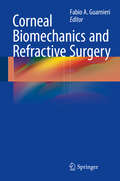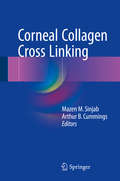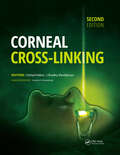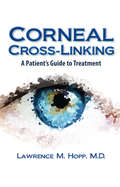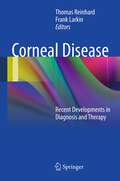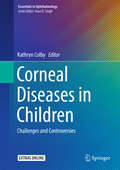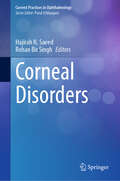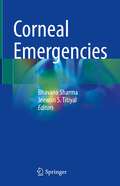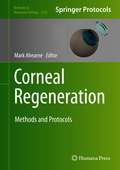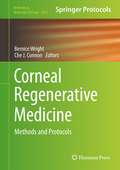- Table View
- List View
Core Topics in Foot and Ankle Surgery
by Andrew Robinson James W. Brodsky John P. NegrineThis concise guide offers an ideal overview of both the practical and theoretical aspects of foot and ankle surgery for trainees and junior consultants. <P><P>Easy to read chapters cover all areas of surgery, from examination, imaging, and the biomechanics of the foot and ankle, to specific conditions including amputations and prostheses, deformities, arthritis, cavus and flat foot, sports injuries, Achilles tendon, benign and malignant tumors and heel pain. Fractures and dislocations of the ankle, hind-, mid- and forefoot are also covered, as are the foot in diabetes and pediatrics. Written by a team of international experts, the text is an accessible way to prepare for postgraduate examinations and manage patients successfully.<P> Each chapter can be read over the course of an evening, meaning readers can quickly develop a broad and balanced view of an area of foot and ankle surgery.<P> The book's modular approach helps the reader strengthen their knowledge of these disorders.<P> The multi-author format of the text offers the reader an international perspective of the surgical management of the foot and ankle.
Core Topics in Neuroanaesthesia and Neurointensive Care
by Martin Smith Basil F. Matta David K. MenonCore Topics in Neuroanesthesia and Neurointensive Care is an authoritative and practical clinical text that offers clear diagnostic and management guidance for a wide range of neuroanesthesia and neurocritical care problems. With coverage of every aspect of the discipline by outstanding world experts, this should be the first book to which practitioners turn for easily accessible and definitive advice. Initial sections cover relevant anatomy, physiology and pharmacology, intraoperative and critical care monitoring and neuroimaging. These are followed by detailed sections covering all aspects of neuroanesthesia and neurointensive care in both adult and pediatric patients. The final chapter discusses ethical and legal issues. Each chapter delivers a state-of-the art review of clinical practice, including outcome data when available. Enhanced throughout with numerous clinical photographs and line drawings, this practical and accessible text is key reading for trainee and consultant anesthetists and critical care specialists.
Core Topics in Obstetric Anaesthesia
by MacLennan, Kirsty and O’Brien, Kate and Macnab, W. Ross Kirsty Maclennan Kate O’brien W. Ross MacnabThis new addition to the highly successful Core Topics in Anaesthesia series provides a clinically relevant text for both trainees and consultants, covering the entire sub-specialty of obstetric anaesthesia. In-depth coverage of pregnancy-related physiology and pharmacology makes this book an excellent revision tool for basic science examinations. It is also a troubleshooting guide for anaesthetists when managing parturients suffering with concurrent medical conditions including obesity, sepsis, hypertensive, renal, respiratory, neurological, haematological and endocrine diseases. Chapters provide recommended management plans for specific conditions such as HIV and neuropraxia following regional anaesthesia, and include algorithms to guide clinical decision-making. Guidance on the required infrastructure for setting up services such as antenatal clinics is also included. Experts in their fields have contributed sections including allergy testing and immunology, the immunocompromised parturient, and maternal collapse. This practical resource will serve as a survival guide for all those caring for parturients on the delivery suite.
Core Topics in Paediatric Anaesthesia
by Ian James Isabeau Walker James Ip Grant StuartFully revised and updated, the second edition of this important book covers the key topics in paediatric anaesthesia in a concise and structured format, providing key management principles for practitioners. Incorporating the latest advances in clinical practice and anaesthesia, it guides readers through the complications and complexities of the field, from the premature infant to the teenager. It covers the common surgical conditions encountered in daily practice alongside a comprehensive discussion of consent and the law, safeguarding children and the complexity of drug dosing in the paediatric population. Additional topics include trauma, burns, resuscitation, principles of intensive care, transporting a sick child and information on the paediatric-specific areas of ethics and medicolegal concerns. Established experts in the field share a wealth of practical experience, providing all the essential information required for advanced paediatric anaesthesia training. This book is an essential reading for trainee and practising paediatric anaesthetists and general anaesthetists managing children.
Core Topics in Paediatric Anaesthesia
by Ian James Isabeau WalkerThis book covers all of the important elements of paediatric anaesthesia in a concise and structured manner. From the premature infant to the teenager, readers are guided through the complexities they may encounter, with key points at the end of each chapter to summarise the most important information. The common surgical conditions encountered in daily practice are covered along with comprehensive discussion of consent and the law, safeguarding children, and the complexity of drug dosing in the paediatric population. Other topics covered include trauma, burns, resuscitation, principles of intensive care, and transporting a sick child. Each chapter is written by an acknowledged expert in their field, sharing a wealth of relevant, practical experience. Covering the whole curriculum necessary for advanced training, this is essential reading for trainees, general anaesthetists managing children in non-specialist hospitals and anyone aspiring to become a paediatric anaesthetist, as well as those established in the field.
Core Topics in Preoperative Anaesthetic Assessment and Management (Core Topics)
by Mark MacGregor A. Agatha Crerar-GilbertPart of the popular Core Topics series, this book provides a practical guide to pre-operative assessment for consultants and trainee anaesthetists. Chapters cover comprehensive evidence-based guidance for assessing and managing patients with particular conditions, as well as perioperative risk stratification and challenges of pre-assessment. The chapters have been written by specialists in the respective clinical fields, while all content has been edited by anaesthetists to assure it is relevant and accessible to the anaesthetist in the everyday pre-operative clinic. Written specifically for anaesthetists, this resource will allow every reader to contribute effectively in a multidisciplinary approach when assessing and risk stratifying patients to ensure that they are optimised before surgery.
Core Topics in Thoracic Surgery
by Marco Scarci Coonar Aman S. Tom Routledge Francis WellsCore Topics in Thoracic Surgery provides accessible and concise coverage of the topics most often encountered in thoracic surgery practice. This handbook will guide the reader through revision of the topics covered in the FRCS(CTh) examination, and also covers more specialist topics in detail. In-depth technical sections offer guidance for difficult procedures, with useful commentaries from leading surgeons. A broad range of thoracic surgery issues are examined, with the latest evidence and information relevant to the speciality presented in a clear fashion. Combining an easy-to-use revision guide for trainees and a comprehensive reference text for cardiothoracic surgeons and recently appointed consultants, this is a one-stop guide to thoracic surgery. Authored by leading experts in the field, this resource will be invaluable to cardiothoracic surgeons, respiratory physicians and specialist nurses seeking to refresh or expand their knowledge of this field.
Core Topics in Transesophageal Echocardiography
by Robert Feneck John Kneeshaw Marco Ranucci Robert Feneck John KneeshawCore Topics in Transesophageal Echocardiography is a highly illustrated, full color, comprehensive clinical text reviewing all aspects of TEE. The book has been designed to be relevant to all those undertaking TEE. It is intended particularly for those seeking to obtain accreditation in TEE, and the authors have ensured that the European accreditation syllabus is covered in full.
Core Topics in Vascular Anaesthesia
by Carl Moores Alastair F. NimmoVascular surgery and anaesthesia have changed considerably in recent years and become recognised subspecialties, although non-specialist anaesthetists continue to provide much of the care for emergency vascular surgical patients. Core Topics in Vascular Anaesthesia brings together the clinical expertise of global leaders in the field in a comprehensive review of contemporary practice. Detailed discussion is included on every aspect of clinical management: • Preoperative risk assessment, including cardiopulmonary exercise testing and risk modification using pharmacological and cardiac interventions • Anaesthesia for major vascular operations including carotid endarterectomy, complex endovascular aortic surgery and repair of ruptured aortic aneurysms • Intraoperative management of high risk patients including advanced monitoring techniques, fluid management, blood conservation and transfusion, major haemorrhage and treatment of coagulopathy Practical and well illustrated, Core Topics in Vascular Anaesthesia is essential reading for anaesthetists, intensive care physicians and vascular surgeons.
Core Values in Family Medicine: Inspiring Global Change (WONCA Family Medicine)
by Felicity Goodyear-Smith Anna Stavdal Johann Agust SigurdssonThis new book explores the core values of family medicine nationally, regionally, and globally, to identify if and/or where there is consensus and where these diversify in relation to contextual factors. Aligned with the WHO’s definition of primary healthcare and goal of universal health coverage and the United Nations Sustainable Development Goals, the book documents a global enquiry by teams of experts representing each world region on the vision, mission, core values and principles, and definition of family medicine in different countries. Each team has adopted different approaches and strategies in their exploration, findings, and conclusions.A common identity for family doctors is important for research agendas, training, recognition of the specialty, and advocacy. However, there is much diversity within and across the regions in the training and the practice of the discipline of family medicine, reflected in the core values. The ultimate goal is a shared vocabulary of humanity for colleagues throughout the world, enriched rather than hindered by their differences.KEY FEATURES: Addresses the core values and principles in family medicine and primary care across the globe, built around the central elements of care that is patient centred, equable, and community and science oriented, with professionalism and cooperation as key themes Supports primary care/family medicine providers in their dual goals of caring for the whole person and adapting to the evolving needs of the population of people under their care, tailored to reflect the specific needs in different world regions Considers the challenges of fragmented care, digital technologies, comorbidities, and growing health inequity Accessible, practical, and international The book will be an invaluable guide for general practitioners, family physicians, family medicine specialists, and other primary care doctors and a useful reference for other primary care health professionals including practice, school and other primary care nurses, medical assistants, paramedics, and community pharmacists. It will also serve as recommended or supplementary reading in undergraduate medical and nursing programmes, in university-based postgraduate courses and master programmes in relevant primary care–related topics, and in vocational training programmes in general practice/family medicine.
Core-Shell Nano Constructs for Cancer Theragnostic: Current Scenario, Challenges and Regulatory Aspects
by Jayvadan K. Patel Namdev Dhas Gaurav Kant SaraogiThis book addresses the critical challenge in cancer treatment, focusing on the precise delivery of therapeutic agents to cancer cells while sparing healthy tissue. It emphasizes the limitations of current cancer therapies and highlights the potential of nanotechnology to revolutionize cancer treatment. It discusses how core-shell nano constructs, with their enhanced stability, biocompatibility, and targeting capabilities, emerge as a promising solution. The book covers the synthesis of novel core-shell nano constructs while elaborating on the chemistry involved in their fabrication. It explores various therapeutic and diagnostic applications of these nano constructs in cancer treatment, considering different materials such as polymers, lipids, and metals and the importance of diagnostics, biosensors, and targeting strategies to achieve site-specific delivery while minimizing toxicity to healthy cells. Additionally, the book addresses regulatory and commercialization aspects,emphasizing the need for comprehensive characterization techniques to assess the effectiveness of core-shell nano constructs. This book is an invaluable resource for students, researchers, and professionals in the field.
Cornea Casebook (Current Practices in Ophthalmology)
by Rohan Bir Singh Fasika Ambachew WoretaThe book discusses the challenging cases presenting with corneal disorders and novel approaches adopted for their management with a detailed description of the disease accompanied by illustrative images. The cornea subspeciality has rapidly progressed over the past two decades. The evolution and adoption of sophisticated diagnostic technologies and development of highly efficacious novel therapies have added to the armamentarium of cornea specialists. The book aims to provide a reliable and comprehensive manual for step-by-step approach in diagnosis and treatment of both the commonly encountered and rare cases in the clinics. This volume of the Current Practices in Ophthalmology book series serves as a valuable resource for practicing ophthalmologists, cornea fellows, vision science researchers, ophthalmology residents, and general ophthalmologists.
Cornea and External Eye Disease: Corneal Allotransplantation, Allergic Disease and Trachoma (Essentials in Ophthalmology)
by Thomas Reinhard Frank LarkinThe 8 recurring volumes of the "Essentials in Ophthalmology" series cover the most recent developments in one of eight subspecialties in Ophthalmology. With four volumes published per year, each subspecialty is newly visited every 24 months, with a distinct focus on recent developments. By bridging the gap between original research and medical textbooks, the transfer of this developing knowledge into daily practice is greatly enhanced.
Cornea: Color Atlas And Synopsis Of Clinical Ophthalmology (Color Atlas and Synopsis of Clinical Ophthalmology)
by Christopher RapuanoPublisher's Note: Products purchased from 3rd Party sellers are not guaranteed by the Publisher for quality, authenticity, or access to any online entitlements included with the product. Developed at Philadelphia’s world-renowned Wills Eye Hospital, the Color Atlas and Synopsis of Clinical Ophthalmology series covers the most clinically relevant aspects of ophthalmology in a highly visual, easy-to-use format. Vibrant, full-color photos and a consistent outline structure present a succinct, high-yield approach to the seven topics covered by this popular series: Cornea, Retina, Glaucoma, Oculoplastics, Neuro-Ophthalmology, Pediatrics, and Uveitis. This in-depth, focused approach makes each volume an excellent companion to the larger Wills Eye Manual as well as a practical stand-alone reference for students, residents, and practitioners in every area of ophthalmology.
Corneal Biomechanics and Refractive Surgery
by Fabio A. GuarnieriThis book presents a unique approach not found in any other text for those looking to improve the clinical results of refractive surgery by gaining a better understanding of corneal biomechanics and the instrumentation related to it. Written by leading experts in the field, this book provides authoritative coverage of the interactions of the cornea and the bioinstrumentation, such as corneal topography, pachymetry, aberrometers, tonometry and optical coherence tomography. Organized in an easy-to-read manner, Corneal Biomechanics and Refractive Surgery is designed for refractive surgeons and general ophthalmologists alike and describes the biomechanical role of the corneal tissue and how each part is affected in refractive surgery. Additionally, showing what the bioinstrumentation can measure, how models can improve understanding of the interaction between biomechanics, bioinstrumentation, and refractive surgery, and how these models and bioinstrumentation together can improve the refractive results, are also discussed.
Corneal Collagen Cross Linking
by Mazen M. Sinjab Arthur B. CummingsThis book provides comprehensive coverage of corneal collagen cross-linking (CXL), a major management modality for keratoconus and ectatic corneal disorders. All aspects are covered, including refractive and non-refractive surgery indications, models of application, safety, efficacy, performance, outcome measures, evidence of CXL, complications, contraindications, use in children, and controversies. The discussion reflects the considerable progress that has been made in understanding of the modality since its development in the late 1990s. Detailed attention is paid to new concepts, changing surgical techniques and indications, the latest evidence-based science and research, and the future of CXL. Guidance is also provided on the use of CXL in combination with other modalities, such as LASIK, PRK, intracorneal ring implantation and others. The text is accompanied by numerous high-quality color illustrations. Corneal Collagen Cross Linking will provide the reader with a sound grasp of the technique and its use and will hopefully also serve as a stimulus to further research and advances.
Corneal Cross-Linking
by J. Bradley Randleman Farhad HafeziCorneal Cross-Linking, Second Edition represents an innovative approach to treating primary acquired and secondary induced ectatic disorders. In addition, corneal cross-linking (CXL) has promising applications as an alternative in the treatment of corneal infectious and non-infectious melting, as well as conditions such as Fuchs’ endothelial dystrophy. The new and expanded Second Edition of Corneal Cross-Linking by Drs. Farhad Hafezi and J. Bradley Randleman will provide a concise yet comprehensive summary of the CXL process, including the basic science foundations, treatment protocols and outcomes, recognition and management of potential complications, and modification of standard protocol for special circumstances. Given all the changes in this rapidly progressing field, many brief topics from the first edition have now grown into full chapters or sections. These include expanded sections on alternative treatment protocols, corneal imaging and biomechanics, combing cross-linking with other refractive treatments, and a section devoted specifically to the most highly debated controversies in the field today. With each chapter being fully updated plus including over twenty new chapters that covers the latest advances and future directions, Corneal Cross-Linking, Second Edition represents the cutting-edge of CXL research and clinical practice. “Since the publication of the first edition of this book in 2013, our knowledge of corneal cross-linking has again significantly increased, both scientifically and clinically. Today, concise recommendations (guidelines for cross-linking) help the clinician to select the patients, make decisions, and provide optimal treatment” -Eberhard Spoerl, PhD and Theo Seiler, MD, PhD
Corneal Cross-Linking: Treatment for Cornea Disease
by Lawrence M HoppHave you been diagnosed with corneal disease? If so, you undoubtedly have questions. How will your eyesight be affected? How can your condition be treated? What are the potential complications of treatment? Dr. Lawrence M. Hopp, M.D., M.S. is a cornea specialist, fellowship-trained in refractive surgery, who has treated thousands of patients with diseases of the cornea. He understands your concerns and offers information that will help ease your anxiety. In Corneal Cross-Linking: Treatment for Cornea Disease, he discusses how cornea diseases develop and how they are best treated. He covers such topics as: signs and symptoms of corneal diseases; corneal disease diagnosis; newest treatments, such as collagen linking, cornea transplants and when they are needed, potential complications of treatment, and more.
Corneal Disease: Recent Developments in Diagnosis and Therapy (Essentials In Ophthalmology Ser.)
by Thomas Reinhard Frank LarkinThis book, written by leading clinicians and scientists, focuses on recent clinically relevant advances in the diagnosis and treatment of corneal disorders. After an opening chapter considering the latest knowledge on the heredity of keratoconus, important advances in corneal imaging are discussed, in particular the use of optical coherence tomography and in vivo confocal microscopy for evaluation of the normal and the diseased cornea. Antiangiogenic treatment options are then reviewed, and new aspects in the diagnosis and therapy of mycobacterial keratitis explained. Further chapters address the storage of donor cornea for penetrating and lamellar keratoplasty and the keratoplasty in infants. The book closes by discussing new developments in antibacterial chemotherapy for bacterial keratitis.
Corneal Diseases in Children: Challenges and Controversies (Essentials in Ophthalmology)
by Kathryn ColbyThis book provides comprehensive coverage of the most important corneal diseases in children, including congenital corneal opacities, infectious keratitis, corneal ectasia, ocular surface disorders and allergic eye disease. Highlights include an extensive discussion of corneal surgery in children, in-depth coverage of the role of various anterior segment ocular imaging modalities in the diagnosis and management of corneal diseases in the pediatric population, and surgical videos to further assist the reader. Chapters dedicated to amblyopia management and contact lens use in children round out the volume. Corneal Diseases in Children stands out as one of the few books dedicated to this important topic.
Corneal Disorders (Current Practices in Ophthalmology)
by Rohan Bir Singh Hajirah N. SaeedThe book comprises a comprehensive update on corneal disease and its management, beginning with a detailed description of the disease and accompanied by illustrative color photos. Chapters contain a section on future directions and new technologies. The book aims to bridge the gap in the literature and educate both trainees and practicing ophthalmologists on the most recent modes of detection and management of corneal disease. This volume is a handy resource for post-graduate residents in ophthalmology and subspecialty fellows, practicing corneal specialists, vision science researchers, and general ophthalmologists alike, aiding in everyday clinical practice as well in preparation for clinical case discussion and examinations.
Corneal Emergencies
by Bhavana Sharma Jeewan S. TitiyalThe book provides a comprehensive insight into various corneal emergencies along with their risk factors, causative agents, diagnostic pearls, treatment challenges and management options. It provides essential information on relevant anatomical and physiological aspects in addition to epidemiology and risk factors. Comprising of explanatory flow diagrams, diagnostic and treatment algorithms and high-quality illustrations, this book is written and edited by renowned corneal specialists who have come together to address this complex topic in a simple and effective manner. The book highlights an important aspect of cornea which is relevant for specialists and general ophthalmologists alike and also serves as an important resource for postgraduate students and trainees. It emphasizes on the practical management of corneal emergencies, supplemented with preferred practice patterns and guidelines. Additionally, the book serves as a quick reference for ophthalmic practitioners to adequately manage such cases at the point of first contact.
Corneal Infection and Inflammation: A Colour Atlas
by Noopur GuptaThis book is a comprehensive treatise on infective and inflammatory pathologies of the cornea with corresponding clinical images and diagrammatic illustrations. Corneal infections and inflammations are a major cause of ocular morbidity and visual impairment. Early diagnosis and treatment can lead to improved visual outcome and quality of life. Both infectious (bacterial, fungal, viral and protozoan) and non-infectious keratitis that cause corneal vascularisation, scarring and vision loss are covered extensively. The illustrated clinical findings presented in the form of diagrams, photographs, cases and videos aim to serve as a practical teaching tool for fellows, trainees and practising ophthalmologists. KEY FEATURES Focuses on clinically relevant parts of corneal diseases, using illustrations with arrows indicating different pathologies and signs Serves as a ready clinical compendium for trainees, fellows and ophthalmologists Explores various corneal pathologies through a wealth of accompanying illustrations and teaching videos
Corneal Regeneration: Methods and Protocols (Methods in Molecular Biology #2145)
by Mark AhearneThis volume details different laboratory techniques used to develop regenerative therapies that help treat corneal blindness. Chapters guide readers through methods and protocols on optimal cell culture conditions, gene-editing techniques, multiple types of scaffold for corneal regeneration, how to evaluate the success of these therapies, and cell and material characterization techniques. Written in the highly successful Methods in Molecular Biology series format, chapters include introductions to their respective topics, lists of the necessary materials and reagents, step-by-step, readily reproducible laboratory protocols, and tips on troubleshooting and avoiding known pitfalls.Authoritative and cutting-edge, Corneal Regeneration: Methods and Protocols aims to be useful for new and experienced laboratory researchers working on different aspects of corneal regeneration.
Corneal Regenerative Medicine: Methods and Protocols (Methods in Molecular Biology #1014)
by Che J Connon Bernice WrightContinuous regeneration of the cornea is necessary to maintain this tissue in the transparent state that is essential for vision. Therapy for repair of the damaged anterior cornea is currently addressed through the transplantation of donor corneas or the delivery of limbal epithelial stem cells (LESC) to the ocular surface using amniotic membrane (AM) as a supporting scaffold. Research on the bioengineering of corneal equivalents as replacement tissue is underway to develop viable corneal prosthetics. Corneal Regenerative Medicine: Methods and Protocols provides a concise overview of essential techniques in the field of corneal regenerative medicine, highlighting novel strategies to guide the management of key therapies within this area of medicine. Divided into four convenient sections, topics include the identification, characterisation and cultivation of LESC, as well as the investigation of biopolymers used as the basis for corneal substitutes. Written in the successful Methods in Molecular Biology series format, chapters include introductions to their respective topics, lists of the necessary materials and reagents, step-by-step, readily reproducible protocols, and notes on troubleshooting and avoiding known pitfalls. Authoritative and easily accessible, Corneal Regenerative Medicine: Methods and Protocols covers the fundamental techniques useful for both the laboratory and clinical settings.
